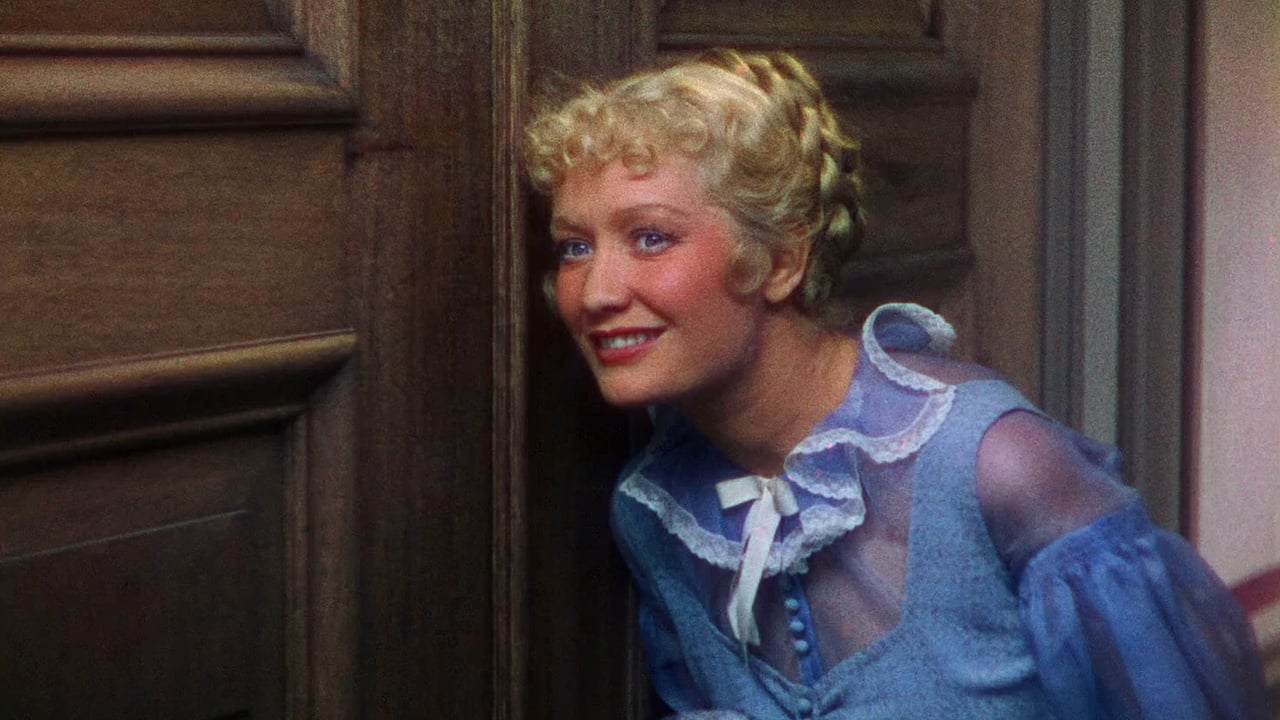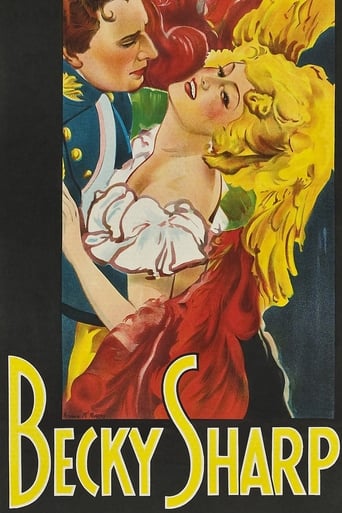

BECKY SHARP (Pioneer Pictures, released through Radio Pictures, 1935), directed by Rouben Mamoulien, stars Miriam Hopkins in the title role for earned her an Academy Award nomination as Best Actress. Produced at the time where classic literature from famous British novelists as Charles Dickens were brought to life on the motion picture screen, BECKY SHARP, from the famous novel "Vanity Fair" by William Makepeace Thackeray, is most notable mainly for being the first feature film produced entirely in the new and improved Technicolor process. Though Thackeray's Becky Sharp did get produced to the motion picture screen all as "Vanity Fair" in the silent era (1915, 1923), and an early sound modern-dress adaptation for Allied Studios (1932) starring non-other than Myrna Loy of all people, this latest edition may be the best known but one that should have been an another surefire hit to the studio's earlier success of LITTLE WOMEN (1933). At 83 minutes, this screen comedy-drama, centering upon Becky Sharp and her scheming ways of winning affections of wealthy men, does have its good points, especially when Becky lies, cheats and cries convincingly to those listening her sob stories, while all the while she's laughing from inside thinking what a bunch of fools they are. There's a couple of instances where she lets her victims know she's made fools of them and happy about her accomplishment. At one point Becky does make amends to the hurt she's done Amelia, but throughout, Becky retains her ambition as a social climber, no matter what the odds.Set in 19th Century England, and basic "Virtue is its own reward" theme, the story opens with Amelia Sedley (Frances Dee), a popular student among classmates and teachers, leaving the boarding school of Miss Pinkerton's Academy. Also at that school is her closest friend, Becky Sharp (Miriam Hopkins), a not-so-popular girl boarding there as a charity case. As Miss Pinkerton (Elspeth Dudgeon) offers Amelia a going away gift of "Doctor Johnson's Dictionary" as a token of her affection, Amelia surprises everybody by having Becky come home and remain with her until she able to support herself. During the course of time, Becky flirts with Amelia's buffoonish brother, Joseph (Nigel Bruce). When things begin to look serious in their relationship, his father sends him away to India. As Amelia finds herself with two childhood suitors, Captain William Dobbins (Colin Tapley) and George Osborne (G.P. Huntley Jr.), and decision which one to marry, Becky soon lands a position as governess for Pitt Crawley (William Stack) and his unruly children. She agrees to the position upon meeting Captain Random Crawley (Alan Mowbray) of the British Army, who then offers her a new position caring for his rich aunt, Julia (Alison Skipworth), and later another position as his wife. During a society ball hosted by the snobbish Lady Barreacres (Billie Burke), Becky attracts the attention of the Marquis of Steyne (Cedric Hardwicke) who becomes fascinated by her. The function is interrupted by cannon sounds at a distance, where soldiers, including Random, immediately take off to what's to become Napoleon Bonaparte's battle at Waterloo. After the war, problems arise for Becky as Random meets with 500 pound gambling debt, and her husband's suspicions as to how she acquired the large sum of money to help pay off his debts. Other members of the cast include: William Faversham (Duke of Wellington); Charles Richman (General Tufts); Doris Lloyd (Duchess of Richmond); Leonard Mudie (Lloyd Tarquin), among others.A public domain title, BECKY SHARP began circulation on video cassette starting in the early 1980s about the same time when broadcast on cable television stations as Arts and Entertainment (A&E). It wasn't until March 1993 that the fully restored Technicolor BECKY SHARP with RKO Radio logo intact aired on American Movie Classics as part of its film preservation festival, and then a decade later on Turner Classic Movies (TCM premiere: December 2, 2002), and availability onto DVD from various media sources.BECKY SHARP appears to contain only small passages to famous pieces of both book and play, which explains why such notable performers as Alison Skipworth and Billie Burke appearing ever so briefly. Had the movie followed the book closely, chances are BECKY SHASRP might have been close to two hour mark or further in its storytelling. Though Hopkins handles her characterization well, it's a wonder how a natural born British actress like Elsa Lanchester in a rare starring role might have handled it? Aside from colorful costumes and mostly British cast, there's also shadowy images captured on the wall and strong musical background that leave a lasting impression and "virtue is its own reward" for Miriam Hopkins. (***1/2)
... View MoreIt's pretty hard to believe that the first color movie came out only eight years after the first talking film! Then again, it seems really weird. It took only four years for every movie to have sound, but it took thirty years for every movie to have color! You can tell that this is the first color movie. I think there are a few transition scenes that look black and white or at least in low quality. It's weird because there isn't much else to say about the movie. I guess the good technically outweighs the bad in this, but I wouldn't quite recommend it.I think the film's problem is that it's too short. It shows the title character becoming more cynical, but the transition seems too fast. There should have been more time to flesh out her personality. I had no idea that this took place during the Napoleonic era. It was really nice to see how those historical events affected the actual story here. It seems to be a part of history that hasn't been depicted in film that many times before.Weird, I heard this was in public domain, but I don't see it listed on Wikipedia's list. I guess I can't quite recommend it, as the story isn't that memorable, but it's still wonderful to see the earliest use of full color. There were in fact earlier movies like "The King Of Kings" that had some color sequences, and that is in fact a much better movie. Still a must for really historians of any kind. **1/2 out of ****.
... View MorePretty BECKY SHARP, orphaned & penniless, knows exactly what she wants out of life and how to get it.William Makepeace Thackeray's Vanity Fair is brought to vivid, if drastically reduced, life and provides a wonderful showcase for star Miriam Hopkins, who gets the most out of her selfish, petulant, scheming, desperate character. Her Becky is fascinating to watch and dominates nearly every scene in the film, making us forget that the actress is not English and forgive that the character is rather less than virtuous.Miss Hopkins is aided by a sizable cast of seasoned veterans, mostly British, several of whom only appear in a single scene. Frances Dee has very little to do except look lovely as Becky's school chum. Nigel Bruce comes off rather better as Miss Dee's obese brother who adores Becky. The incomparable Alison Skipworth plays their quarrelsome old aunt who hires Becky for a short while. Alan Mowbray has a fine romantic role as the husband who worships Becky, to his pain.Marvelous Sir Cedric Hardwicke successfully underplays his role as a powerful nobleman who takes Becky as his mistress. Wonderful Billie Burke appears for a few moments in a serious role as a society lady attending a soirée in Brussels. Doris Lloyd is the hostess.Three short, sharp portrayals worth watching for are provided by Elspeth Dudgeon as an acidic girls' school proprietress; George Hassell as a rascally old baronet; and Tempe Pigott as a plain-talking charwoman.BECKY SHARP is important historically in that it was the first film produced in full 3-strip Technicolor. Director Rouben Mamoulian's opulent production was a worthy choice for such a distinguished accolade. Restored in the 1990's, the color is once again most pleasing to the eye.
... View More"Becky Sharp" seems to have consistently attracted unfair comments. Whilst it may not be as subtle as many of its contemporary counterparts, the story provides a fun basis for a glorious use of Technicolor. As the first feature length movie to be shot in full colour, the film is a wonderful example of cinema as spectacle. Though admittedly, at times, the viewer may almost be sent cross-eyed by the vibrancy of the colour, its use is interesting in so far as one can see the attempts made at one level to exhibit the colour, whilst also trying in vain not to distract from the narrative. Also, from the beginning of the opening sequence the status of the film as a stage adaptation is clear, and in this way the idea of the now overlooked tradition of cinema as spectacle is further enhanced.The plot itself is slightly reminiscent of a Gainsborough melodrama (although it precedes them), and yet it is refreshing in many ways that Becky is not the subject of the traditional narrative retribution and resolution. The over-the-top nature of some of the narrative action does provide moments which may cause an audience member to cringe; however, if the film is not taken too seriously, it remains enjoyable."Becky Sharp" has too often been overlooked in the history of film. It may not have been widely popular at the time of its release, and it may not be seen within a high cinematic cannon, but it is definitely worth viewing, if only to appreciate the emergence of three colour film as the new advancement in film technology.
... View More